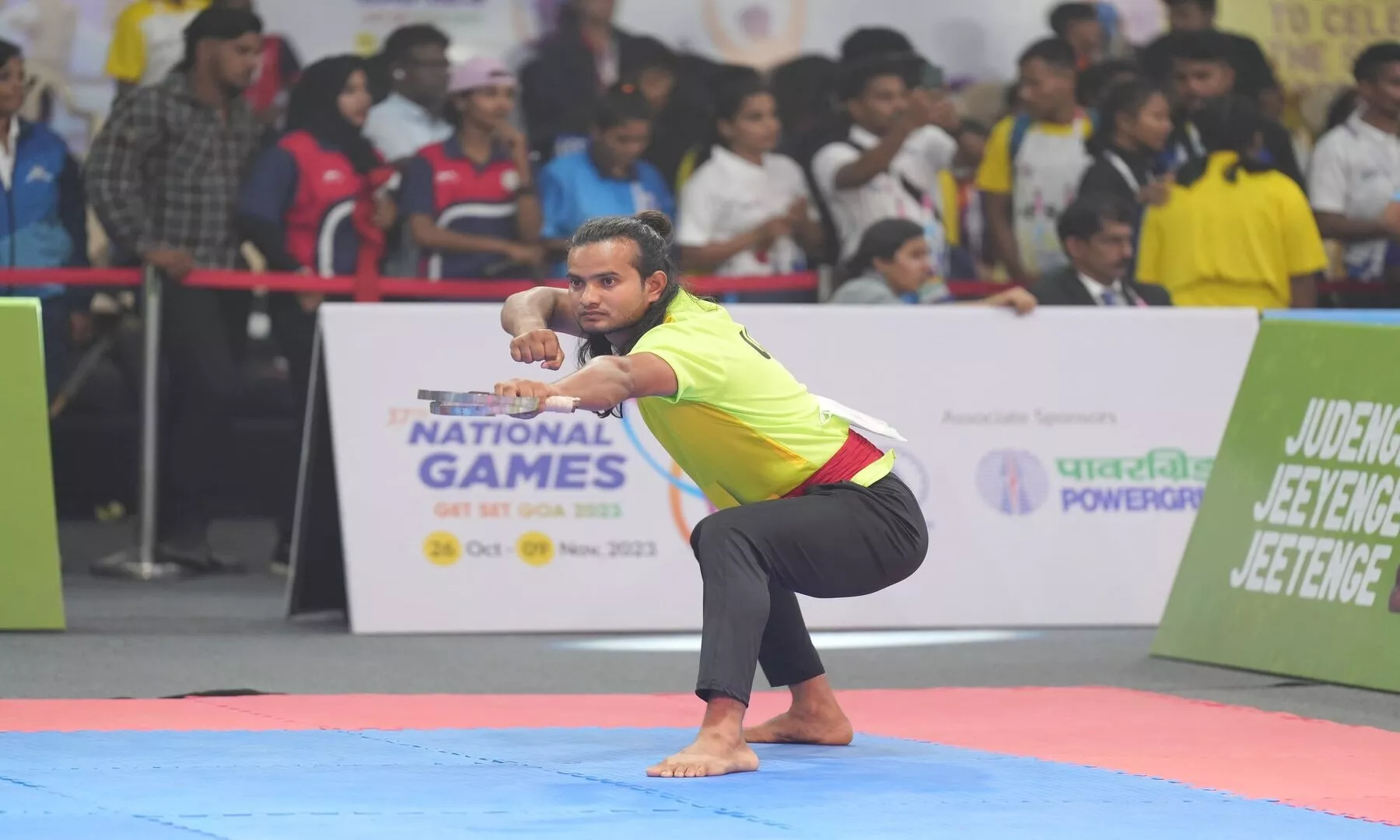Kalaripayattu: Ancient martial art of Kerala that made an impactful appearance in its debut National Games 2023

From its historical roots to its artistic expressions, Kalaripayattu is a fascinating blend of culture, tradition, and sport.
Amidst the lush green coastal areas of Kerala, where coconut palms sway in the breeze and the air is filled with the scent of spices, a centuries-old martial art form has quietly flourished over centuries.
Kalaripayattu, often referred to as the mother of all martial arts, is a captivating blend of physical prowess, cultural heritage, and spiritual depth. In recent years, this ancient art form has been experiencing a renaissance, captivating the world with its graceful yet powerful movements. This combat sport has also made its debut in the ongoing 37th edition of the National Games in Goa, where 224 athletes from 16 states in the country participated.
“It is indeed the mother of all martial arts. There is no doubt about that. It has been a huge honor for all of us that we got a chance to showcase this unique sporting event at the National Games in Goa,” said Adv. Poonthura Soman, Secretary-General, Indian Kalarippayattu Federation.
“Kalarippayattu was included as a demonstrative sport in the 2015 National Games hosted by Kerala. We were all under the impression that we would see another National Games in 2016, but that did not happen. So, we had to wait till this year to be able to see Kalarippayattu getting its due recognition as a competitive sport,” he added.
Kalarippayattu traces its origins back more than 3,000 years in Kerala, a state immensely rich in tradition and history. The name itself is derived from two Malayalam words, "kalari," meaning battlefield, and "payattu," meaning fight. Developed by the warrior class, it was designed as a means of self-defence and combat training. Kalarippayattu was a well-kept secret for many centuries, only passed down from guru to disciple in hidden training grounds known as kalari.
The sport flourished in the 11th century AD during the rule of the powerful dynasties of Cholas, Cheras, and the Pandyas. However, during British rule, the sport was banned for the fear of revolution. It was in the year 1955, with the introduction of the Indian Kalarippayattu Federation (IKF), that the combat sport gradually regained its popularity as part of the initiative to promote traditional art forms in the southern part of India.
“We are thankful to the Government of India for giving us the recognition that we truly deserved for a long time. A sport like Kalarippayattu, deeply ingrained in the Indian ethos and culture, deserves to be promoted so that more youth take active interest in it,” Soman said.
“In 2016, UNESCO included Kalaripayattu on its Representative List of the Intangible Cultural Heritage of Humanity, highlighting its cultural significance and the need to preserve it for future generations,” he further added.
One of the most captivating aspects of Kalarippayattu is its artistic and fluid movements. Practitioners seem to glide gracefully through the air, demonstrating a striking combination of strength, agility, and coordination. This dance-like quality is not coincidental; Kalarippayattu has a rich tradition of incorporating graceful movements into its martial repertoire.
“It is this unique blend of physical combat and artistry that sets it apart from many other martial arts,” said Malini Awasthi, Coach and current Vice President of the Karnataka Kalaripayattu Federation.
What’s more, Kalaripayattu encompasses an array of weapons training, adding to its mystique. The most iconic of these weapons are the long staff, double-edged sword, flexible sword, and the dagger. Each weapon has its own set of intricate techniques and forms, making it a comprehensive martial art system that can be practiced throughout one's life. For enthusiasts, learning about these weapons is not just about knowing the sport but also an exploration of history and culture.
While Kalaripayattu remained somewhat obscure for many years, Soman said it has been experiencing a resurgence in recent times, both in India and around the world. The surge in interest can be attributed to several factors.
“One of the main reasons for its revival is the increased global interest in holistic wellness practices. Kalarippayattu is not just a physical discipline; it's deeply rooted in the philosophy of Ayurveda and yoga. The practice emphasizes the balance of the mind, body, and spirit, making it appealing to those seeking a holistic approach to well-being,” Soman said.
With Kalaripayattu finally getting its eureka moment in the Goa nationals, Soman is hopeful that the athletes will help preserve its traditions in the coming days.
“Kalarippayattu has shown its remarkable ability to evolve and transcend over time, making it an art form that will continue to inspire and captivate people for generations to come.”
“Today, many countries such as Malaysia, Thailand, Indonesia, and even France have shown active interests in this combat sport. Our mission is to take Kalaripayattu to as many countries as we can in the next five years and make it a regular feature in international events. That’s our main goal,” Soman concluded.
- National Games: Three Talking Points from Goa 2023
- Former world junior champion Mandeep Kaur hopes to become self-reliant after securing successive medals at National Games
- National Games 2023: Jyothi Yarraji, Tejas Shirse shine with meet records
- National Games 2023 Medal Tally Updated: Maharashtra emerge champions after 29 years
- National Games 2023: Srihari Nataraj named Best Male Athlete; Sanyukta Kale, Pranati Nayak win Best Female Award